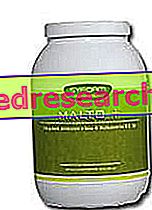What is that
The modified starch is produced by subjecting chemical-physical treatments of various nature to the starch contained in cereals and tubers. In this way it is possible to enhance, if necessary, the application characteristics required by the various industrial sectors.
Depending on the alterations undergone, the modified starch can acquire resistance to overheating, cooling, cutting, swelling, gelatinization or acidity.
Use in food
Modified starch is widely used in common food products; it is in fact added as a gelling and thickening additive to puddings, tomato sauces, mayonnaise and yogurt, which become thicker, acquiring semi-solid consistencies much appreciated by the consumer.
Food Additive
As food additives, modified starches are marked with the abbreviations:
E1404 - E1410 - E1412 - E1413 - E1414 - E1420 - E1422 - E1440 - E1450 - E1451 - E1452
In the labels of food products modified starch is however declared under the category name (therefore without the E code, nor the single name).
Safety

To confirm that this is not something dangerous, the directive that regulates its use in the European Union does not establish any maximum daily dose, although it requires specifying the plant origin on the label (modified corn starch, modified starch of tapioca etc.).
Diet and health
Despite this quantitative freedom, the exaggerated consumption of modified corn starch can still create some problems; its use, in fact, raises the caloric content of the food and in fact reduces its genuineness and nutritional value.
As the natural counterpart, in fact, it contains many calories, but it is devoid of those nutritional factors - such as vitamins, proteins or minerals - present in the raw material that it replaces. For example, the addition of modified starch to fruit yoghurt reduces the lean dry residue of the starting milk (which will therefore have less protein, vitamins, minerals and everything that is not fat).
It is no coincidence that modified starches are typically added to light foods to maintain the organoleptic qualities (taste and texture) despite the reduction in nutrients.



